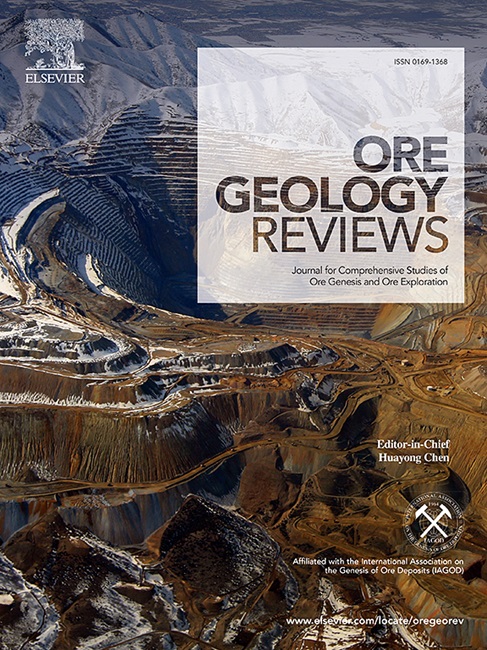Compositions of in-situ trace elements, S and Pb isotopes of pyrite in Mengqiguer deposit, Yili basin, NW China:implications for uranium mineralization processes of sandstone − type uranium deposit
IF 3.2
2区 地球科学
Q1 GEOLOGY
引用次数: 0
Abstract
Pyrite, a prevalent authigenic mineral in sandstone-type uranium deposits, was examined in the Mengqiguer deposits to elucidate its role in the mineralization process. The investigation utilized polarizing microscopes, scanning electron microscopy (SEM), and Femtosecond Laser Ablation Inductively Coupled Plasma Mass Spectrometry (Fs-La-ICP-MS) to systematically analyze the morphology, genetic sequence in relation to uranium minerals, trace element composition, and sulfur (S) and lead (Pb) isotopic signatures of pyrite. Microscopic observations identified diverse forms of pyrite: pyrite debris (Py1), framboidal pyrite (Py2), fine euhedral pyrite (Py3), and pyrite cement (Py4). Py3 was further categorized into Py3-U (within the ore, in contact with uranium minerals) and Py3-x (in the surrounding rocks, without contact). Py1 predated diagenesis, while Py2 and Py3 formed during the uranium mineralization stage, and Py4 emerged in the late mineralization period. Trace element analysis revealed a decrease in Co, Ni, As, Se, Mo, W, and U contents from Py3-U to Py3-x to Py4. Py3-U, closely linked to uranium mineralization, showed elevated uranium levels and lower δ34S values (−53.99 ‰ to −50.22 ‰), indicative of a biogenic origin. The Co-Ni distribution pattern of Py3-U and Py3-X suggests that the formation of the Mengqiguer deposit may have been influenced by the spontaneous combustion of coal seams, leading to higher formation temperatures. The increased 206Pb/204Pb and 207Pb/204Pb ratios in pyrite are attributed to uranium decay during mineralization, serving as a marker for pyrite formed during this stage. However, the considerable variation in 206Pb/204Pb and 207Pb/204Pb ratios necessitates a comprehensive mineralogical analysis to identify pyrite associated with mineralization using lead isotope ratios. The Mengqiguer uranium minerals are predominantly pitchblende, present as fine pitchblende particles or pitchblende cement. The formation of uranium minerals and pyrite are closely related, with Py3-U being the contemporary mineral of uranium minerals. Specifically, during the uranium pre-enrichment stage, pyrite dissolves and releases Fe3+, aiding in the migration and enrichment of uranium (U). In the early mineralization stage, pyrite acts as a reductant, promoting uranium precipitation. During the main mineralization period, significant biological activity reduces Fe3+ and U6+ to form new pyrite (Py2/Py3) and fine pitchblende particles, undergoing multiple dissolution-precipitation cycles. In the superimposition stage of mineralization, pyrite and uraninite transform into cementing materials. Consequently, pyrite and its interaction with uranium minerals together shape the complexity and diversity of uranium mineralization.

求助全文
约1分钟内获得全文
求助全文
来源期刊

Ore Geology Reviews
地学-地质学
CiteScore
6.50
自引率
27.30%
发文量
546
审稿时长
22.9 weeks
期刊介绍:
Ore Geology Reviews aims to familiarize all earth scientists with recent advances in a number of interconnected disciplines related to the study of, and search for, ore deposits. The reviews range from brief to longer contributions, but the journal preferentially publishes manuscripts that fill the niche between the commonly shorter journal articles and the comprehensive book coverages, and thus has a special appeal to many authors and readers.
 求助内容:
求助内容: 应助结果提醒方式:
应助结果提醒方式:


